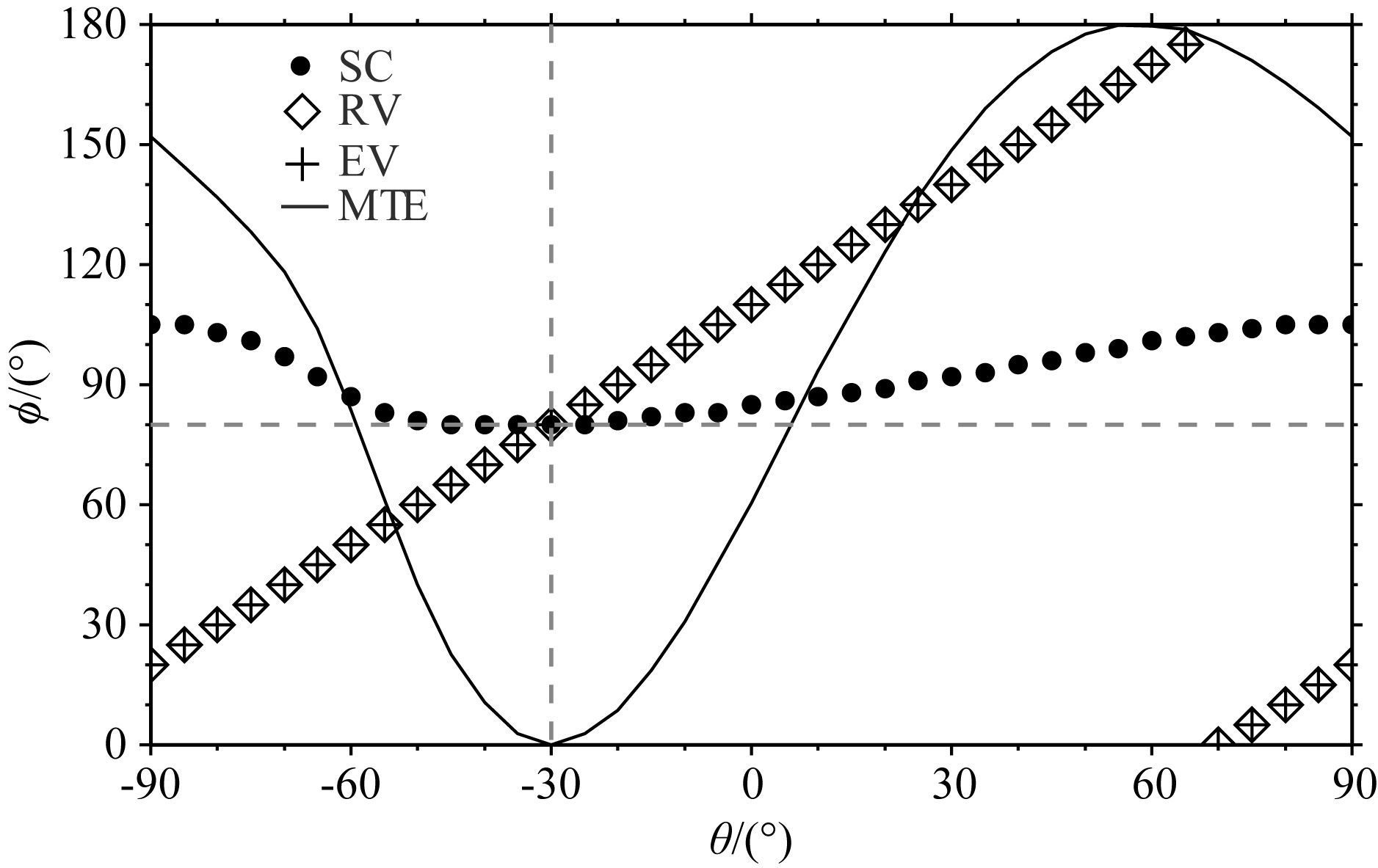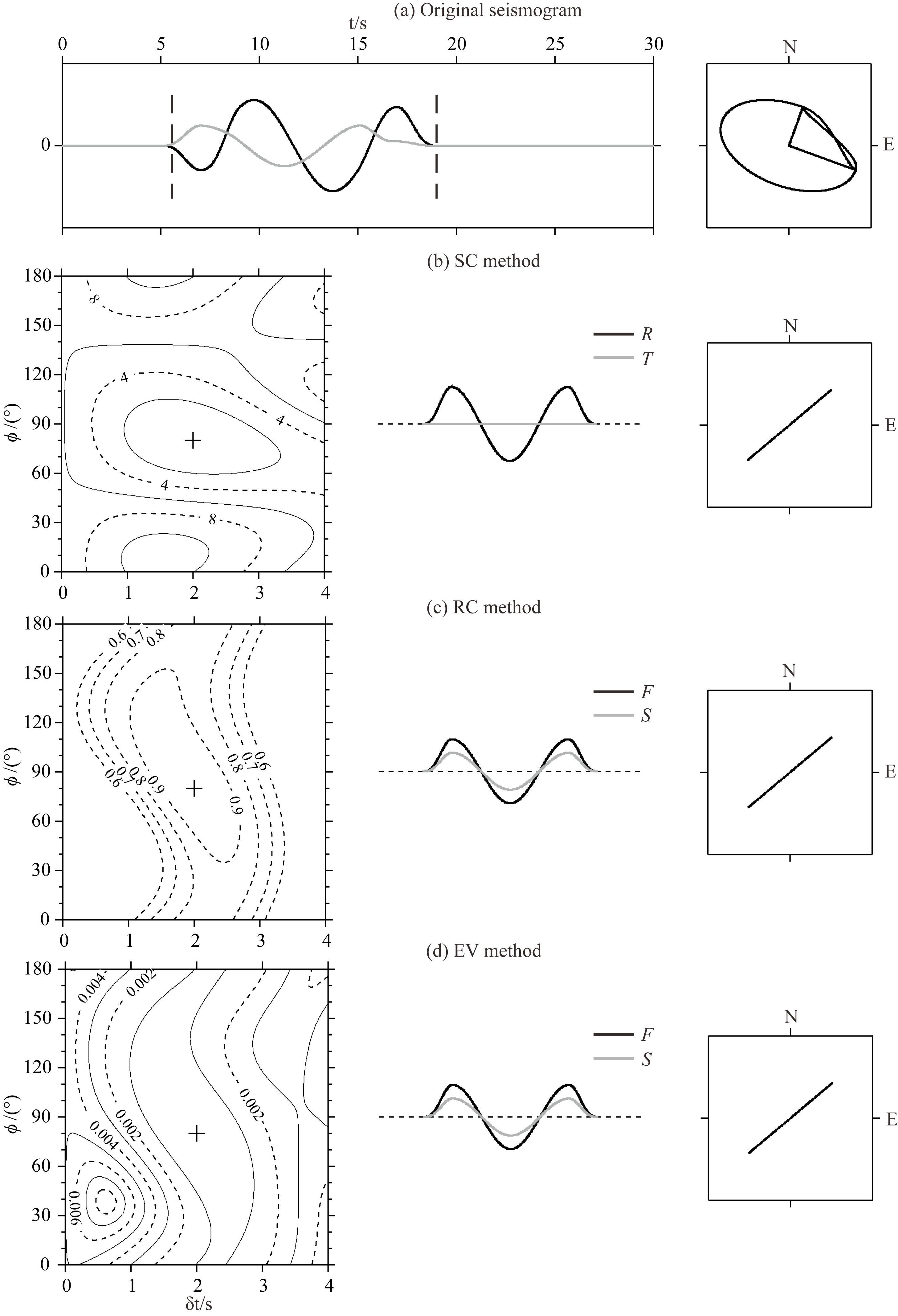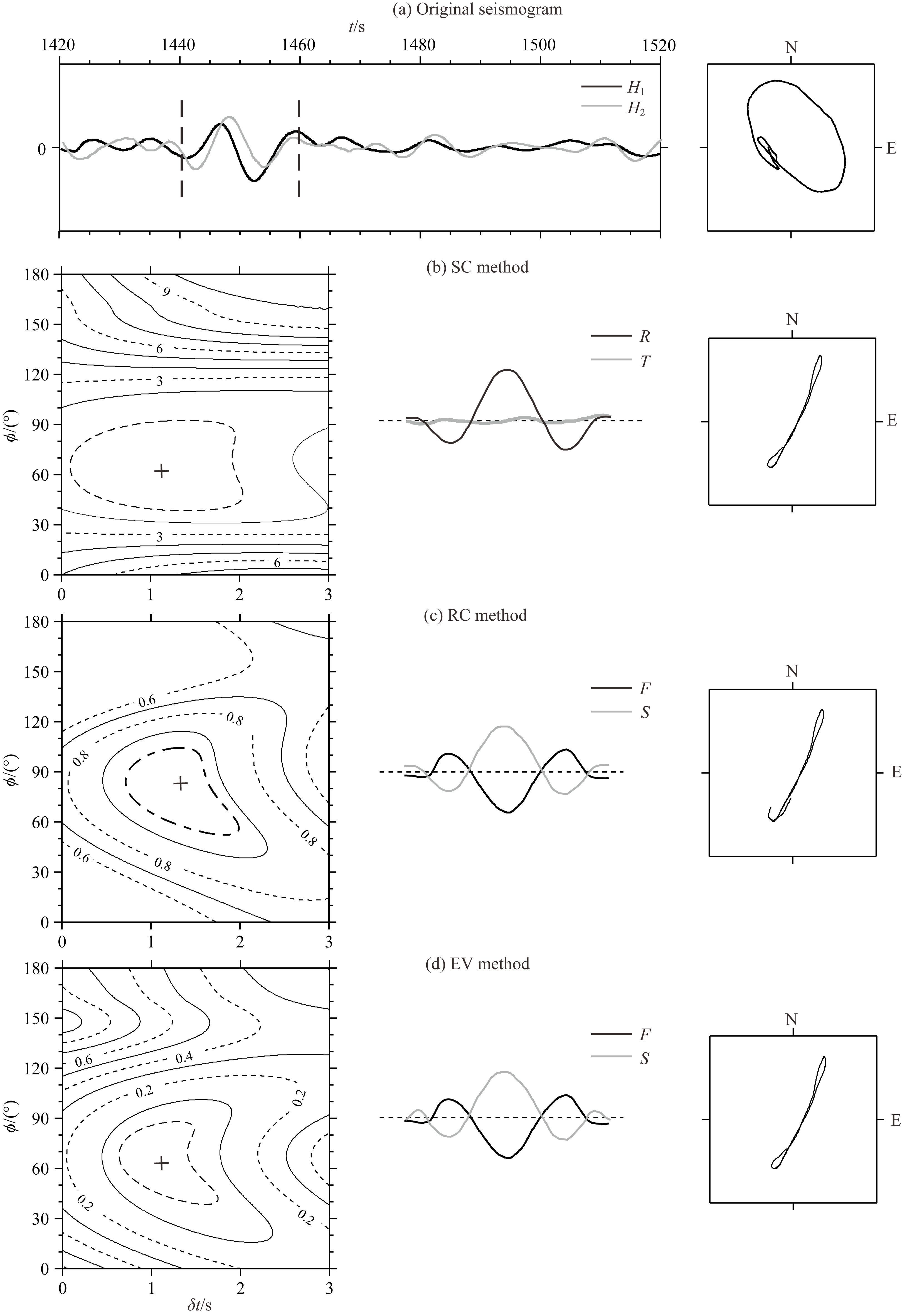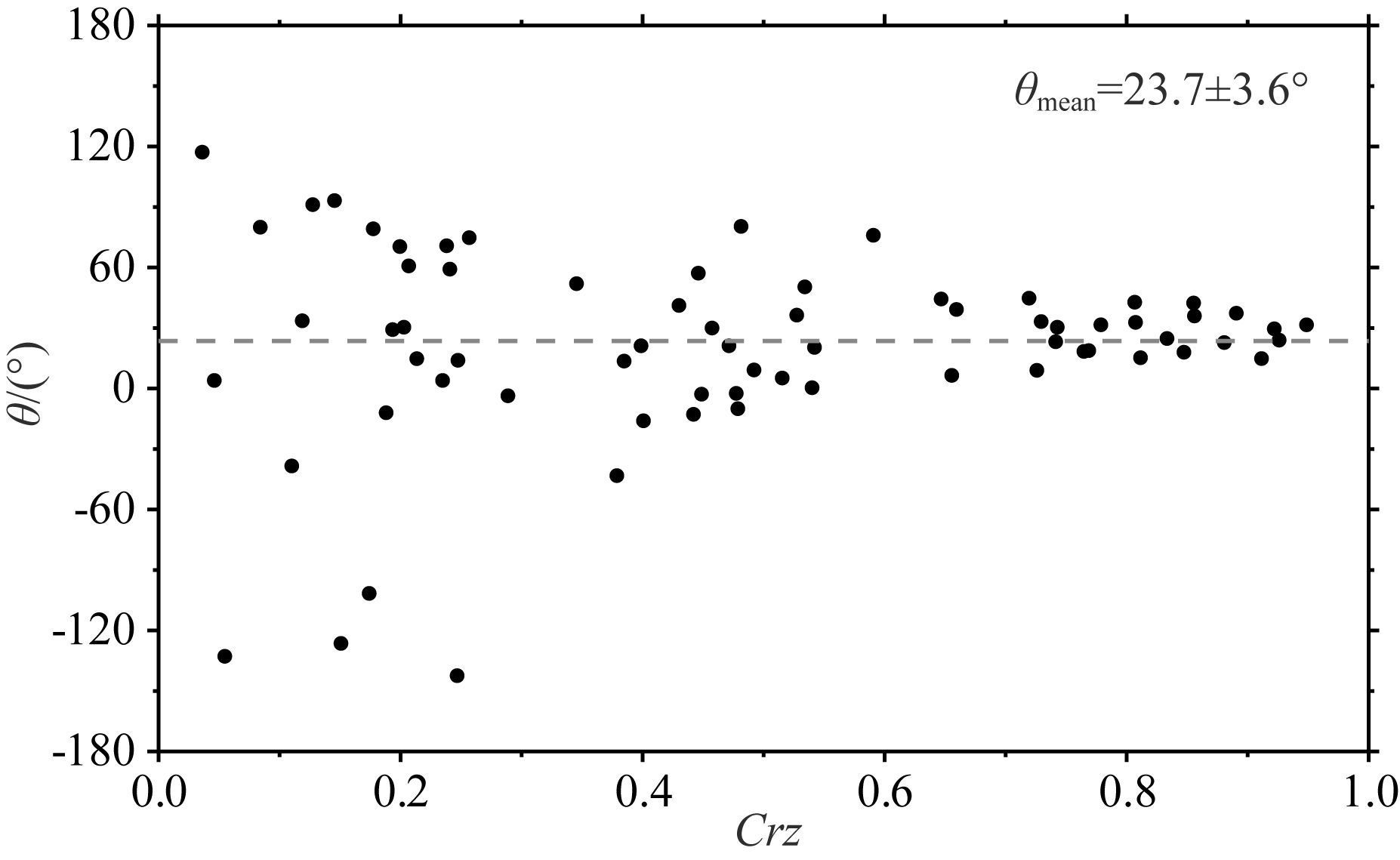2. 国家海洋局第一海洋研究所, 青岛 266061;
3. 同济大学海洋地质国家重点实验室, 上海 200092;
4. 中国海洋大学, 青岛 266100
2. First Institute of Oceanography, State Oceanic Administration, Qingdao 266061, China;
3. State Key Laboratory of Marine Geology, Tongji University, Shanghai 200092, China;
4. Ocean University of China, Qingdao 266100, China
海底地震仪 (OBS) 及其组成的海底流动地震观测台阵是近年来发展起来的高新技术,已成为研究海底深部结构最有效的地球物理方法,其在海洋壳幔速度结构,板块俯冲带特征,洋盆演化动力学机制,地震活动性监测以及地震、海啸预警等方面都有广泛的用途 (Shen et al., 1998; Niu et al., 2007; Tahara et al., 2008; Shinohara et al., 2008; Zhao et al., 2010; 郝天珧和游庆瑜, 2011; 阮爱国等, 2011; Kumar et al., 2011; ).地震各向异性研究是了解地壳和地幔变形的有效方法之一.研究认为,上地幔各向异性主要是由上地幔中橄榄岩等矿物晶格的优势排列引起的 (Silver, 1996),因此,通过各向异性的研究可以推测地球内部物质运动模式.目前,通过SKS分裂参数测量获取海底上地幔各向异性属性已成为近期研究的热点 (Gideon et al., 2001; Barruol et al., 2009; Growdon et al., 2009; Collins et al., 2012).
在各向同性介质中,SKS波在穿过核幔边界,由P波转换为S波时,S波只有径向分量 (SV波),没有切向分量 (SH波),质点运动在射线路径平面内作线性偏振.如果地幔中存在各向异性介质,则SKS波会分裂成一个沿各向异性对称轴方向的偏振快波和一个与快波偏振方向垂直的偏振慢波,观测到的SKS偏振方向会发生改变,质点运动由原来的线性偏振变为椭圆偏振,快慢波所走路径几乎相同,但有明显的到时差 (图 1).因此,用两个分裂参数快波偏振方向 (φ) 和快慢波到时差 (δt) 用来指示上地幔的各向异性属性,其反映了橄榄岩等矿物晶格的优势排列方向和各向异性的强度.最常用的SKS分裂参数测量方法有三种:包括基于切向能量最小化的最小能量法 (SC)、基于快慢波波形相似的旋转相关法 (RC),以及协方差矩阵最小特征值法 (EV) (Bowman and Ando, 1987; Silver and Chan, 1988; Vinnik et al, 1989; Silver and Chan, 1991; Iidaka and Niu, 2001; Levin et al., 1999).其原理是通过网格搜索寻找分裂参数 (φ, δt) 将两个水平分量旋转分解到快波方向和慢波方向,分别使得校正后的切向能量最小、快慢波的相关系数最大以及快慢波分量协方差矩阵的特征值最小.

|
图 1 台站接收SKS波分裂示意图 H1和H2表示未知方位的两个水平分量;Fast和Slow分别表示台站接收到的SKS分裂后的快慢波;θ为台站A水平分量方位角;φ为SKS快波方向;δt为SKS快慢波到时差. Fig. 1 Illustration of the SKS splitting received in station H1 and H2 represent two horizontal components of unknown direction; Fast and Slow are fast and slow waves after SKS splitting, respectively; θ is the horizontal orientation of the OBS sensors; φ is the fast wave direction; δt is the time difference between the fast and slow wave. |
由SKS分裂方法原理可知,SKS分裂参数测量需要知道确切的水平分量的方位.在陆内布设宽频带地震计时,我们可以通过罗盘确定其方位;然而,OBS在投放过程中是自由式的,其两个水平分量在海底的方位是不确定的 (图 1).因此,传统的海底地震仪SKS分裂参数测量分为两个步骤:首先计算OBS的水平分量方位,然后再进行SKS分裂参数测量.根据不同的数据类型和震相选择,研究者采取不同的方法计算OBS水平分量方位.第一类方法是利用气枪激发已知偏振方向的信号来确定OBS的方位角 (Anderson et al., 1987; Duennebier et al., 1987).因为此方法需要气枪作为主动震源,这一方法并不总是很容易实现.第二类方法是利用OBS记录到的远震信号的特征来确定其方位.主要包括:①根据OBS记录到的P波或者地震面波 (瑞雷波) 的质点运动方向特征,利用已知地震位置,并结合统计分析来确定水平分量方位 (Stachnik et al., 2012);②通过计算远震数据和合成地震图的相关性来确定OBS水平方位 (Ekstrom and Busby, 2008).但由于海底洋流和次重力波的影响,在远震波段 (20~100 s周期) OBS所获得的水平分量存在较大的噪声干扰 (Crawford and Webb, 2000),这大大减少了可利用的高质量的远震事件,另外,如果远震事件都集中于某一特定的方位内 (例如俯冲板块边缘),介质的不均匀性会导致OBS水平分量定向的偏差.第三类方法是利用环境噪声的互相关分别提取台站间垂向与径向、垂向与垂向间的格林函数,然后通过这两个格林函数最大相关来确定OBS水平分量方位 (Zha et al., 2013).然而,此方法在有大量台站时能获得较高精度的结果,而在台站数量较少,或者台站分布不够分散的情况下,则会导致OBS水平分量定向的偏差,影响所获得的结果.
综上各种求取OBS水平分量方位的方法都存在着一定的局限,而且先获取OBS水平分量方位,再进行SKS分裂参数测量,会产生累积误差,降低最终SKS分裂结果的可靠性.解决以上问题的一个途径是将上面两个过程缩减为一个过程,即同时获得OBS水平分量方位和SKS分裂参数.在本文中,我们根据SKS快慢波运动学特性,发展了一种在未知OBS水平分量方位的情况下直接求取SKS分裂参数的方法.此方法可以减少累积误差,获得的SKS分裂参数可靠性更高.
2 原理与方法 2.1 方法原理由于地磁场影响或者研究者操作失误,陆上宽频带地震仪在野外布设过程中,水平分量方位存在方位偏差是不可避免的.为解决这一问题,Tian等 (2011)提出一种全局最小切向能量法进行SKS分裂参数测量,基本原理是:假定水平分量存在方位偏差,用不同的角度θ旋转水平分量,然后多次进行SKS分裂参数测量.在这些测量中,如果选取的角度θ正好能够校正水平分量的方位偏差,此时获得的最小切向能量应该具有全局最小,而且通过SC和EV方法得到的分裂参数应该一致 (RC方法易受噪声影响,故忽略其结果),此方法很好地解决了SKS分裂参数测量过程中陆内宽频带地震仪水平分量方位偏差问题.
受此方法启示,我们发展了一种在未知OBS水平分量方位情况下测量SKS分裂参数,并同时获取OBS水平分量方位的方法.假定不同的水平分量方位θ,由三种方法 (SC、RC以及EV) 求取最优分裂参数的原理可知,其无法区分SKS波的极性,分裂参数随水平分量方位呈180°周期变化,故水平分量方位角θ在-90°~90°之间扫描,然后将其旋转到南-北、东-西方向,进行多次SKS分裂,当水平分量方位θ与实际情况相符时,三种方法得到的SKS分裂参数将满足以下两个条件:(1) 用最小切向能量方法求取SKS分裂得到的切向能量具有全局能量最小;(2) 用最小切向能量方法 (SC) 和最小特征值方法 (EV) 所获得的SKS分裂结果相同.此时获得的SKS分裂参数即为所求的结果,θ或者θ+180°即为OBS水平分量方位 (图 2).

|
图 2 快波方向 (φ) 和最小切向能量 (MTE) 随方位角θ的变化 当使用一个合适的方位角θ=-30°时,三种方法SC (圆点)、RC (菱形) 和EV (十字) 得到的快波方向 (φ) 变为一致;同时,最小切向能量值MTE (细线) 也达到一个全局最小. Fig. 2 The fast direction (φ) and the minimum transverse energy (thin line) variations with the orientation angle θ The results ofthe fast direction (φ) from three methods, SC (closed circles), RC (diamonds) and EV (crosses), become consistent when an appropriate offset angle θ is used. Meanwhile, the transverse energy always reaches a global minimum at θ=-30°. |
用合成一个带阻尼的正弦信号作为入射SKS震相来检验此方法的可行性.该震相周期为8 s,以反方位角BAZ=40°穿过各向异性对称轴φ0=80°、快慢波分裂时差为δt0=2.0 s的介质,被OBS检波器接收,并假设OBS水平分量相对于正北方向逆时针偏转30°,即水平分量方位为-30°.根据以上信息,可以得到OBS两个水平分量上合成SKS震相的振幅 (图 3a),扫描不同的水平分量方位θ(-90°<θ < 90°,步长为1°),然后旋转水平分量至南-北、东-西方向,再用三种测量方法SC、RC和EV扫描介质的各向异性参数:快波方向φ的扫描范围为0°~180°,步长为1°;分裂时差δt的扫描范围为0~4 s,步长为0.02 s.图 2为三种测量方法获得的快波方向φ以及最小切向能量值 (MTE) 随水平分量方位角θ的变化,为了更好的表达,我们将其在-90°到90°进行了归一化处理.从图中可以看出,当水平分量方位角θ=-30°时,切向能量达到全局最小,同时,三种测量方法求得的快波方向φ也达到一致.图 3(b-d)为水平分量顺时针偏转30°时,RC、SC和EV三种方法所得到的模型的分裂参数.三种方法所得分裂结果一致:快波方向φ=80°,分裂时差δt=2.0 s,与我们给定的模型参数一致,理论上证明该方法是可行的.

|
图 3 合成波形的分裂测量结果 (a) 合成的原始地震图具有反方位角为40°,分裂参数为φ0=80°, δt0=2.0 s,两个水平分量逆时针方向偏转了30°,即θ=-30°.其中左侧图为两个水平分量H1和H2,垂直虚线所截取的部分是进行SKS分裂的时窗;右侧展示原始的质点运动轨迹.(b)(c) 和 (d) 展示了分别通过SC、RC以及EV方法获得的分裂结果.其中左侧一列三种方法的等值线图,图中的十字为最优分裂参数 (φ0=80°, δt0=2.0 s);(b) 图中间一列为校正后的径向 (R) 和切向分量 (T),(c) 和 (d) 图的中间一列为校正后的快波 (F) 和慢波 (S) 分量;右侧一列为三种方法校正后的质点运动轨迹. Fig. 3 Splitting measurements for the synthetic waveform with a backazimuth of 40° and splitting parameter φ0=80°, δt0=2.0 s; and the north and east components were rotated anticlockwise by 30° to the north (a) The synthetic original seismogram. The left panel shows the H1 and H2 components and the time window (vertical dash line) of the SKS phase analysed. The right panel shows the initial particle motion. (b) (c) and (d) show the measurements of splitting parameters by the SC, RC and EV method, respectively. The left panel is the contour map of three methods. The cross represent the best-fitting parameters (φ0=80°, δt0=2.0 s). The middle panels show the corrected fast and slow component except the top one is the corrected radial and transversecomponents. The right panels are the corrected particle motion. |
用实际观测的远震资料对本文提出的SKS分裂测量方法进行数值检验,以考察实际应用效果.在南海中央海盆的黄岩-珍贝海山链的两侧布设了一个被动源OBS观测台阵 (Xue et al., 2013; Huo and Yang, 2013; Sun et al., 2013),其记录了2012年3月至2014年4月期间全球天然地震信号.本次OBS台阵布设采用自由式投放,故其水平分量的方位是未知的,采用本文提出的方法,利用SKS波记录获取了台阵中的16号台站 (S16) 下方上地幔的各向异性属性.
选择震中距在85°~130°之间,震级大于MS6.0的地震事件用于SKS波分裂测量,共筛选出4个具有清晰SKS震相的波形记录 (表 1).为压制噪声对分裂参数测量的影响,使用二阶Butterworth滤波器对原始数据进行0.03~0.2 Hz的带通滤波,选取SKS震相所在的18 s时窗来求取分裂参数φ和δt.
|
|
表 1 文中S16进行SKS分裂测量所用到的事件信息 Table 1 Seismic events information used in SKS splitting for station S16 |
采用本文提出的方法,用不同的方位角θ分别通过SC,RC和EV方法进行分裂参数测量,图 4和5为表 1中事件3的分裂结果.如图 4所示,三种方法得到的快波方向φ和最小切向能量随着水平分量方位角θ的变化而改变,当方位角θ=20°时,通过SC和EV方法获得的分裂参数达到一致,且切向能量也达到全局最小.我们把两个水平分量逆时针偏转20°至南-北、东-西方向,通过SC和EV方法获得相同的SKS分裂参数φ=62°,δt=1.1 s (图 5b和d).

|
图 4 快波方向 (φ) 和最小切向能量随水平分量方位角θ的变化 当方位角θ=20°时,SC (圆点) 和EV (十字) 方法得到相同的快波方向φ=62°,最小切向能量也达到全局最小. Fig. 4 The variation in the fast direction (φ) with the orientation angle θ (relative to the north) The method SC (closed circles) and EV (crosses) obtain the same result of φ=62° when θ=20°. The transverse energy (thin line) reaches a global minimum at θ=20°. |

|
图 5 事件在水平分量方位校正后的SKS分裂参数测量 在参数测量前,两个水平分量逆时针旋转θ=20°去校正其偏移角度.其中图 (b) 显示SC方法获得的最优分裂参数为φ=62°, δt=1.1 s;(c) 为RC方法获得的最优分裂参数为φ=82°, δt=1.3 s;(d) 显示EV方法获得的最优分裂参数为φ=62°, δt=1.1 s. Fig. 5 SKS splitting measurements after correcting the unknown horizontal component orientation at S16 station from event The two horizontal components were rotated anticlockwise by θ=20° to represent correcting the offset before the splitting measurements. After measurement, the best-fitting splitting parameters are φ=62°, δt=1.1 s by the SC method in (b); φ=82°, δt=1.3 s by the RC method in (c) and φ=62°, δt=1.1 s by the EV method in (d). |
表 2列出了表 1中所有4个事件的分裂参数.4个分裂参数结果平均值为=60±4.5°,δt=1.1±0.2 s.SKS波各向异性反映了由应变导致的上地幔橄榄石晶格的优势排列的方向和强度,最大张应力方向对应SKS快波的偏振方向.本研究得到的SKS快波方向平行于中央海盆的扩张脊,这是因为沿扩张轴的线性张裂造成的橄榄石晶格的优势排列是平行于扩张轴.前人研究表明南海海盆海底扩张是由中央海盆向西南海盆发展 (Briais et al., 1993),因此,两者的各向异性参数应具有一致性.阮爱国等 (2012)对南海西南次海盆的OBS数据的ScS波的各向异性反演显示,西南次海盆的快S波偏振方向约为N58°E,快慢波时差约为0.9 s,与我们的反演结果基本一致,表明本文所提方法可以可靠地获得SKS分裂结果.
|
|
表 2 S16台站4个事件所获得SKS分裂测量结果和水平分量方位 Table 2 SKS splitting results and horizontal component orientation of the station S16 |
从图 2和4可以看出,不同水平分量方位下三种方法 (SC、RC以及EV) 获得SKS分裂参数也不同,RC和EV方法得到的快波方向随着水平分量方位呈线性变化,SC方法则表现为非线性变化.本文中,我们方法求得S16的水平分量方位平均值为21±3.2°(表 2),故该台站的水平分量方位为21±3.2°或者201±3.2°.两者可以通过初至P波垂向分量和径向分量的相关性来区分,径向分量位于一、四象限时,两者存在正相关,当位于二、三象限时,两者存在负相关.若所求的水平方位θ0使垂向分量和径向分量满足上述关系,即OBS真实的水平方位为θ0,若θ0使垂向和径向的相关关系反转,则OBS真实的水平方位为θ0+180°.对S16的初至P波极化分析表明,其垂向分量和径向分量呈正相关,故该OBS台站的水平分量方位为21±3.2°.
为了验证此结果的正确性,我们也用传统方法求取了该OBS台站的水平分量方位.由于缺乏主动源气枪数据,以及台站数量少且分散,仅通过OBS记录到的远震信号的特征来确定其方位,图 6为远震P波质点运动轨迹分析获得的该台站的水平分量方位,结果为23.7±3.6°;另外,前人 (Liu et al., 2014) 利用OBS记录到的地震面波 (瑞雷波) 的质点运行方向特征,结合统计分析得到的水平分量的方位为22.5°.这两种方法与我们的结果也基本一致,表明我们本文所提方法能够可靠地获取SKS分裂参数,而且将OBS水平方位和SKS分裂参数求取两个过程合二为一,减少了累计误差,所求的结果应具有更高的精度.

|
图 6 远震P波质点运动轨迹分析获得的S16水平分量方位 θ为水平分量方位角;Crz为垂向分量和径向分量相关系数. Fig. 6 Horizontal component orientation from teleseismic P wave particle motion analyses θ is the horizontal component orientation; Crz is the coefficients between the vertical and radial component. |
利用宽频带海底地震仪 (OBS) SKS分裂参数测量获取海底上地幔各向异性属性已成为近期研究的热点.因为OBS的自由式投放,决定了其两个水平分量在海底的方位是不确定的,而SKS分裂参数测量需要知道确切的OBS水平分量的方位,因此,在进行分裂参数测量之前需要先求取OBS水平分量的方位,然而求取OBS水平分量方位的方法都存在着一定的局限,而且先获取OBS水平分量方位,再进行SKS分裂参数测量,会产生累积误差,降低最终SKS分裂结果的可靠性.本文通过SKS快慢波的运动学特性,将上述两个过程合并,提出了一种在未知OBS水平分量方位的情况下直接求取SKS分裂参数的方法,用合成地震图和实际远震资料检验表明其是一种有效的获得SKS分裂参数的方法,且应用简便,减少了累积误差,获得的SKS分裂结果可靠性更高.
| Anderson P N, Duennebier F K, Cessaro R K. 1987. Ocean borehole horizontal seismic sensor orientation determined from explosive charges. J. Geophys. Res., 92(B5): 3573-3579. DOI:10.1029/JB092iB05p03573 | |
| Barruol G, Suetsugu D, Shiobara H, et al. 2009. Mapping upper mantle flow beneath French Polynesia from broadband ocean bottom seismic observations. Geophys. Res. Lett., 36: L14301. DOI:10.1029/2009GL038139 | |
| Bowman J R, Ando M. 1987. Shear-wave splitting in the upper-mantle wedge above the Tonga subduction zone. Geophys. J. Int., 88(1): 25-41. DOI:10.1111/j.1365-246X.1987.tb01367.x | |
| Briais A, Patriat P, Tapppnnier P. 1993. Updated interpretation of magnetic anomalies and seafloor spreading stages in the South China Sea:Implications for the Tertiary tectonics of Southeast Asia. J. Geophys. Res., 98(B4): 6299-6328. DOI:10.1029/92JB02280 | |
| Collins J A, Wolfe C J, Laske G. 2012. Shear wave splitting at the Hawaiian hot spot from the PLUME land and ocean bottom seismometer deployments. Geochem. Geophys. Geosyst., 13: Q02007. | |
| Crawford W C, Webb S C. 2000. Identifying and removing tilt noise from low-frequency ( < 0. 1 Hz) seafloor vertical seismic data. Bull. Seismol. Soc. Am., 90(4): 952-963. | |
| Duennebier F K, Anderson P N, Fryer G J. 1987. Azimuth determination of and from horizontal ocean bottom seismic sensors. J. Geophys. Res., 92(B5): 3567-3572. DOI:10.1029/JB092iB05p03567 | |
| Ekström G, Busby R W. 2008. Measurements of seismometer orientation at USArray Transportable Array and Backbone stations. Seismol. Res. Lett., 79(4): 554-561. DOI:10.1785/gssrl.79.4.554 | |
| Growdon M A, Pavlis G L, Niu F L, et al. 2009. Constraints on mantle flow at the Caribbean-South American plate boundary inferred from shear wave splitting. J. Geophys. Res., 114: B02303. | |
| Gideon P, Douglas A, Karen M, et al. 2001. A complex pattern of mantle flow in the Lau backarc. Science, New series, 292(5517): 713-716. | |
| Hao T Y, You Q Y. 2011. Progress of homemade OBS and its application on ocean bottom structure survey. Chinese J. Geophys. (in Chinese), 54(12): 3352-3361. | |
| Huo D, Yang T. 2013. Seismic ambient noise around the South China Sea:seasonal and spatial variations, and implications for its climate and surface circulation. Mar. Geophys. Res., 34(3-4): 449-459. DOI:10.1007/s11001-013-9176-6 | |
| Iidaka T, Niu F L. 2001. Mantle and crust anisotropy in the eastern China region inferred from waveform splitting of SKS and PPSms. Earth, Planets and Space, 53(3): 159-168. DOI:10.1186/BF03352373 | |
| Kumar P, Kawakatsu H, Shinohara M, et al. 2011. P and S receiver function analysis of seafloor borehole broadband seismic data. J. Geophys. Res., 116: B12308. DOI:10.1029/2011JB008506 | |
| Levin V, Menke W, Park J. 1999. Shear wave splitting in the Appalachians and the Urals:a case for multilayered anisotropy. J. Geophys. Res., 104(B8): 17975-17993. DOI:10.1029/1999JB900168 | |
| Liu C G, Hua Q F, Pei Y L, et al. 2014. Passive-source Ocean Bottom Seismograph (OBS) array experiment in South China Sea and data quality analyses. Chin. Sci. Bull., 59(33): 4524-4535. DOI:10.1007/s11434-014-0369-4 | |
| Niu F L, Bravo T, Pavlis G, et al. 2007. Receiver function study of the crustal structure of the southeastern Caribbean plate boundary and Venezuela. J. Geophys. Res., 112: B11308. DOI:10.1029/2006JB004802 | |
| Ruan A G, Niu X W, Qiu X L, et al. 2011. A wide angle Ocean Bottom Seismometer profile across Liyue Bank, the southern margin of South China Sea. Chinese J. Geophys. (in Chinese), 54(12): 3139-3149. DOI:10.3969/j.issn.0001-5733.2011.12.014 | |
| Ruan A G, Li J B, Lee C S, et al. 2012. Passive seismic experiment and ScS wave splitting in the southwestern subbasin of South China Sea. Chin. Sci. Bull., 57(25): 3381-3390. DOI:10.1007/s11434-012-5132-0 | |
| Shen Y, Sheehan A F, Dueker K G, et al. 1998. Mantle discontinuity structure beneath the southern east Pacific rise from P-to-S converted phases. Science, 280(5367): 1232-1235. DOI:10.1126/science.280.5367.1232 | |
| Shinohara M, Fukano T, Kanazawa T, et al. 2008. Upper mantle and crustal seismic structure beneath the Northwestern Pacific Basin using a seafloor borehole broadband seismometer and ocean bottom seismometers. Phys. Earth Planet. Inter., 170(1-2): 95-106. DOI:10.1016/j.pepi.2008.07.039 | |
| Silver P G, Chan W W. 1988. Implications for continental structure and evolution from seismic anisotropy. Nature, 335(6185): 34-39. DOI:10.1038/335034a0 | |
| Silver P G, Chan W W. 1991. Shear wave splitting and subcontinental mantle deformation. J. Geophys. Res., 96(B10): 16429-16454. DOI:10.1029/91JB00899 | |
| Silver P G. 1996. Seismic anisotropy beneath the continents:probing the depths of geology. Annu. Rev. Earth Planet. Sci., 24(1): 385-432. DOI:10.1146/annurev.earth.24.1.385 | |
| Smith G P, Wiens D A, Fischer K M, et al. 2001. A complex pattern of mantle flow in the Lau backarc. Science, 292(5517): 713-716. DOI:10.1126/science.1058763 | |
| Stachnik J C, Sheehan A F, Zietlow D W, et al. 2012. Determination of New Zealand ocean bottom seismometer orientation via Rayleigh-wave polarization. Seismol. Res. Lett., 83(4): 704-713. DOI:10.1785/0220110128 | |
| Sun T, Le K P, Zhang Y W, et al. 2013. Signatures of ocean storms on seismic records in South China Sea and East China Sea. Mar. Geophys. Res., 34(3-4): 431-448. DOI:10.1007/s11001-013-9204-6 | |
| Tahara M, Uehira K, Shimizu H, et al. 2008. Seismic velocity structure around the Hyuganada region, Southwest Japan, derived from seismic tomography using land and OBS data and its implications for interplate coupling and vertical crustal uplift. Phys. Earth Planet. Inter., 167(1-2): 19-33. DOI:10.1016/j.pepi.2008.02.001 | |
| Tian X B, Zhang J L, Si S K, et al. 2011. SKS splitting measurements with horizontal component misalignment. Geophys. J. Int., 185(1): 329-340. DOI:10.1111/gji.2011.185.issue-1 | |
| Vinnik L P, Farra V, Romanowice B. 1989. Azimuthal anisotropy in the Earth from observations of SKS at GEOSCOPE and NARS broadband stations. Bull. Seismol. Soc. Am., 79(5): 1542-1558. | |
| Xue M, Le K P, Yang T. 2013. Seismic anisotropy surrounding South China Sea and its geodynamic implications. Mar. Geophys. Res., 34(3-4): 407-429. DOI:10.1007/s11001-013-9194-4 | |
| Zha Y, Webb S C, Menke W. 2013. Determining the orientations of ocean bottom seismometers using ambient noise correlation. Geophys. Res. Lett., 40(14): 3585-3590. DOI:10.1002/grl.50698 | |
| Zhao M H, Qiu X L, Xia S H, et al. 2010. Seismic structure in the northeastern South China Sea:S-wave velocity and Vp/Vs ratios derived from three-component OBS data. Tectonophysics, 480(1-4): 183-197. DOI:10.1016/j.tecto.2009.10.004 | |
| 郝天珧, 游庆瑜. 2011. 国产海底地震仪研制现状及其在海底结构探测中的应用. 地球物理学报, 54(12): 3352–3361. | |
| 阮爱国, 牛雄伟, 丘学林, 等. 2011. 穿越南沙礼乐滩的海底地震仪广角地震试验. 地球物理学报, 54(12): 3139–3149. DOI:10.3969/j.issn.0001-5733.2011.12.014 | |
| 阮爱国, 李家彪, 李昭兴, 等. 2012. 南海西南次海盆海底地震仪天然地震观测及ScS波分裂. 科学通报, 57(13): 1147–1156. | |
 2017, Vol. 60
2017, Vol. 60


